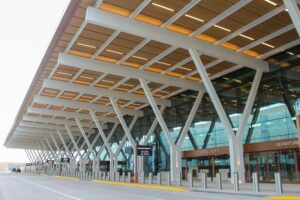Kansas City, Missouri, views its new $1.5 billion airport terminal as a shiny gateway, symbolic of the economic and commercial success that city officials expect is forthcoming.
An improved Kansas City International Airport will open on Tuesday — welcoming passengers with glass jet-bridges, upscale dining options and solar-powered parking garages. The upgraded terminal boasts sensory and simulation rooms to comfort nervous fliers, family play areas and 10 infant feeding rooms.
“This is really a next level type of thing, both in branding for Kansas City, but also in saying really whatever you need, really anything other than a mountain or an ocean, we’ve got,” Kansas City Mayor Quinton Lucas said in an interview. “And I think we have moved our infrastructure in our city from being an impediment to really being a true attribute.”
US airports in the last several years have raced to outfit new terminals with amenities, seeking to ride a rebound in air travel after the coronavirus pandemic. Since 2018, governments have sold more than $85 billion of airport bonds, according to data compiled by Bloomberg.
The Port Authority of New York and New Jersey, the operator of LaGuardia Airport, John F. Kennedy International Airport and Newark Liberty International Airport, is in the midst of a $30 billion renovation to transform the major metro-area travel hubs. And Chicago’s O’Hare International recently launched an $8.5 billion face lift.
While airports are essential to regional commerce, upgrading them doesn’t necessarily spur an immediate economic boom.
“Infrastructure development is really a boon for the economy as a whole,” S&P Global Ratings credit analyst Nora Wittstruck said in an interview. “Airports do sort of compete for demand, and we’ve seen when the airports undertake these modernization projects, which there have been a lot of recently, it can help them give a leg up to airlines.”
The Kansas City airport hadn’t been renovated since opening in 1972. Built in the brutalist-style that was popular at the time, the airport consisted of cement, u-shaped terminals providing little natural light and a crowded travel experience for the growing city. The old terminals are slated to be torn down.
Read full Bloomberg article here.
